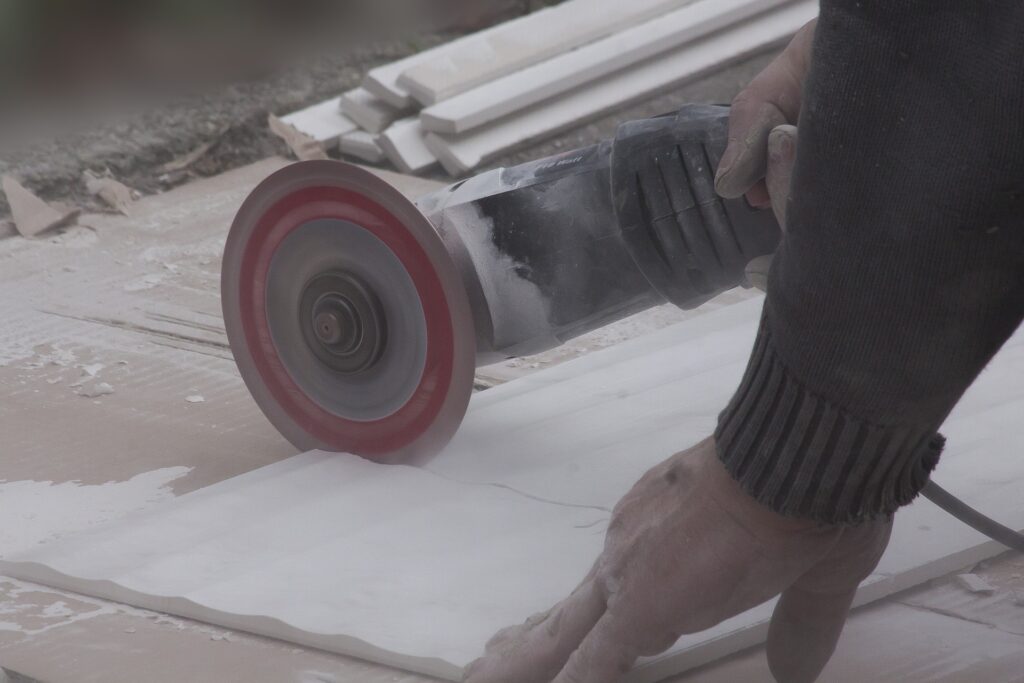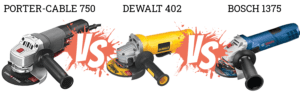Cutting tile is a delicate operation. Unlike wood or metal, tile chips and breaks easily when not handled carefully. Most woodworking tools can’t be used for processing tile without changing the blades or discs. Fortunately, angle grinders are well-suited to cutting tile provided that the correct discs are used.
We’ll review the most common types of tile-cutting angle grinder blades and the pros and cons of each. We’ll also give our recommendations for the best angle grinder wheels for cutting tile in each category.
What Does Wet/Dry Mean?
Wet/dry refers to the cutting conditions for which a particular wheel is designed. It means you can cut tile with or without water. Most angle grinders are dry tools, in that there is no functionality for using water while cutting or grinding.
If you want to explore wet cutting, you’ll need a conversion kit. Check out how to safely and successfully use water with an angle grinder.
Important safety note: dry cutting produces a lot of nasty dust. Silica used in most masonry products is very harmful when inhaled and prolonged exposure can result in some serious health issues.
Continuous Rim Wheels
When you think of a saw blade, you’ll likely envision a metal disc with teeth circumferencing the rim. Continuous rim wheels don’t have such teeth. They don’t have teeth at all, actually.
They are the least aggressive type of tile-cutting wheels since they grind away at tile rather than chipping into it. The rims are sprinkled with diamond abrasives that act as the cutting agent.
The downside to continuous rim wheels is that they are slow.
The upside to continuous rim wheels is that their cuts are very clean.
We like this type of wheel for interior projects like kitchen backsplashes or bathroom floors. The clean cutting action leaves a finish-quality edge that won’t require grout to hide imperfections.
Turbo Wheels
Turbo wheels are a step up from continuous rim wheels in cutting aggression. They don’t have distinct teeth, but their rims feature corrugations that take bigger bites out of masonry sections.
There are different rim designs among different manufacturers but the underlying concept is the same. Some wheels have more aggressive patterns while others stay modest to improve cut quality.
We recommend turbo wheels for heavier masonry materials like pavers or flagstone. They are a little too aggressive for delicate interior tile but are great for landscaping masonry that still needs a presentable cut quality. Thick granite countertops also benefit from the balance of speed and cut quality that turbo wheels offer.
Segmented Wheels
Segmented wheels have distinct teeth and gullets that are common in woodworking blades. They typically have ten or fewer teeth and have abrasive rims much like continuous rim wheels.
These blades are the most aggressive masonry cutting wheels for angle grinders. Their gullets help evacuate dust from the kerf as well as cool the blade during heavy use.
The finish will be much rougher than what can be acheived with more conservative wheels but the ability to quickly chew through difficult material gives these wheels an edge.
Segmented wheels are best used for exterior masonry projects, especially demolition. They easily remove many yards of grout lines when removing bricks or pavers. If a sharp edge isn’t necessary for your intended exterior job, take a look at segmented wheels.
The Best Angle Grinder for Cutting Tile
There actually isn’t an angle grinder that is specifically better for cutting tile. Tile-cutting performance is largely a function of the wheel that you’ve chosen (like those mentioned above).
Nevertheless, there are a few angle grinders that rise above the rest in terms of performance, capability, and price. Check out our comparison of the top cordless angle grinders and corded angle grinders that can cut tile (or most anything else!) well.






